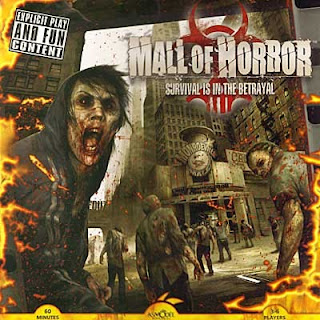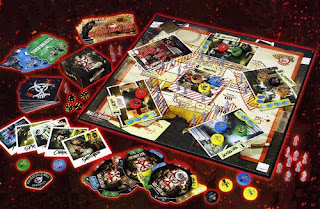
Zombies attack! Survivors hole up in a mall! People are as dangerous as the undead! These are fairly common themes in zombie movies and stories -- and they're the basis for
Mall of Horror. This board game pits three to six players against each other as the zombies amass.
Each player gets three characters: a Pin-Up cheerleader, a Tough Guy, and a Gunman; in a four-player game, each player also gets a Kid. Players also have a voting wheel, used to choose buildings and cast votes.
The board is composed of six buildings. Each building can hold a certain number of people. The Parking Lot can get players action cards (but leave the characters very vulnerable), the Security H.Q. gives advance warning of where zombies are headed, and the Supermarket is more easily invaded by zombies.

Each turn players vote to see who searches the truck (more on voting below), elect a Chief of Security, roll four dice to see where the zombies attack, move characters, and withstand the zombie attack. The game ends when there are only four characters left alive (or six characters in a six-player game) or all remaining characters are in a location other than the Parking Lot. Each player adds up the values of their remaining characters (Pin-up: 7; Tough Guy: 5; Gunman: 3; Kid: 1) and whoever has the most points wins.
The key to
Mall of Horror is voting. When a vote is called for, each character at the location gets a vote --except the Gunman,who gets two votes -- and players secretly vote with their voting wheel. If there's a tie everyone votes. The winner gets to: search the truck in the Parking Lot vote (getting three action cards, then choosing one to keep, one to give away, and one to discard); elect a Chief of Security (who gets to see the die roll indicating where the zombies are heading); or choose which player has to lose characters to the zombies.

Ah, those pesky zombies. After the dice are rolled but before they're revealed, each player uses their voting wheel to select a building to send a character. Then the dice are revealed, and a zombie goes to each building; the building with the most Pin-Ups gets an extra zombie due to the screaming. Next players choose one character to send to their chosen location; if they're sent to a building that's full, the character goes to the parking lot. Then the attack begins!
If there are more characters than zombies (and the Tough Guy counts as two), the attack is repelled -- but the zombies stay at the building. If the number of zombies is equal to or greater than the number of characters there, the players vote on who has to sacrifice a character; then the character is discarded, as are all the zombies at the location. Every zombie at the Parking Lot gets to kill a character, determined by voting. Only four zombies are needed to succeed at the Supermarket, no matter how many players are there. Zombies at an empty building stay there -- and if eight zombies accumulate at an empty building, that building is condemned and no one can go there.
Mall of Horror is a game of mixed quality. This does capture the feel of a zombie uprising, as the zombies are initially fairly easy to repel but, as their numbers increase and the characters start dying, a sense of desperation is felt. Strategy is key, as players have to decide what to go for (control of the Security Office, risk the Parking Lot for cars, or even who to send to a building about to be overrun by zombies.) And the art is appropriately creepy.
The rules are fairly straightforward -- and that can be a problem. With the only real variety being in the action cards, the voting and moving can be repetitive. All the characters have the same art, and each type of character functions the same for all players. There are also a few small translation problems, from awkward wording in the rules ("A mysterious scientific experiment allowed dead to raise to devour the living ones") to the building labeled "Cachou." And while a few action cards will kill zombies (or slow them down), the only true way to win is by sacrificing the others -- which could lead to some hurt feelings among players.
Mall of Horror reminds me of the old joke about two friends who see a tiger charging at them. The first friend starts putting on his running sneakers, the second tells him that he can't outrun the tiger, and the first answers, "I don't have to outrun the tiger. I just have to outrun you." If you and the other players want a horror game about sacrificing opponents instead of directly defeating evil, then
Mall of Horror is for you.
Overall game: B-
Reviewed by James Lynch
 Ah, the romance novel: omnipresent in book stores, often mocked, covers featuring heated embraces, plots that seem repeated over and over. Or are they? Sarah Wendell and Candy Tan, co-creators of Smart Bitches, Trashy Books blog , provide a fan's overview, critique, and love affair of romance novels with Beyond Heaving Bosoms: The Smart Bitches' Guide to Romance Novels.
Ah, the romance novel: omnipresent in book stores, often mocked, covers featuring heated embraces, plots that seem repeated over and over. Or are they? Sarah Wendell and Candy Tan, co-creators of Smart Bitches, Trashy Books blog , provide a fan's overview, critique, and love affair of romance novels with Beyond Heaving Bosoms: The Smart Bitches' Guide to Romance Novels.




















